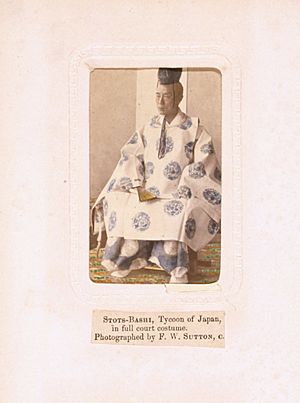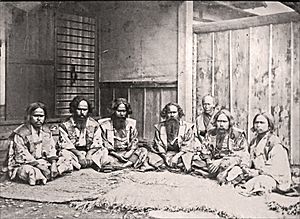Frederick William Sutton facts for kids
Quick facts for kids
Frederick William Sutton
|
|
|---|---|

Studio portrait of Tokugawa Yoshinobu, taken by Sutton (1867)
|
|
| Born | 29 August 1832 |
| Died | 28 January 1883 (aged 50) |
| Occupation | Naval Engineer, Photographer |
| Spouse(s) |
Georgina Margaret Drummond
(m. 1858) |
Frederick William Sutton (born August 29, 1832 – died January 28, 1883) was an English naval engineer. He was also an early amateur photographer. Sutton is most famous for his photos taken in Meiji period Japan.
Contents
Sutton was born in Woolwich, United Kingdom on August 29, 1832. His father was a civil engineer. In 1854, Sutton joined the Royal Navy. This was at the start of the Crimean War.
He served on HMS St Vincent and later HMS Simoom. The Simoom helped supply troops in Crimea. In May 1855, his ship fought in a naval raid at Sevastopol. He was promoted several times in the Navy. By 1864, he became a Chief Engineer.
Family Life and Later Years
In 1858, Sutton married Georgina Margaret Drummond. His time in Japan was very important to him. He even named his youngest daughter Ume, which is a Japanese name. His last home was called 'Nihon', meaning 'Japan'.
Sutton returned to England in 1879. He had health problems in 1881. He passed away on January 28, 1883. His death was due to heart issues.
Adventures in Japan: Photography and Surveys
In April 1865, Sutton joined the HMS Serpent. This steam-warship was sent to the China Sea. Its job was to survey the area. By 1867, the Serpent explored the west coast of Japan. This was because the port of Hyogo was about to open for foreign trade.
In May 1867, the ship docked near Osaka. British officials met with Japanese leaders there. They discussed where foreign settlements would be. Sutton's ship also surveyed the North West Coastline. This area had not been surveyed by the British since the 1790s.
First Photos of Japan
The Navy asked Sutton to use his camera in May 1867. He began taking pictures in Osaka Bay. In August 1866, Sutton's ship escorted a diplomat named Minister Parkes. Parkes asked Sutton to photograph Tokugawa Yoshinobu. Yoshinobu was the last shogun of Japan.
On May 1, 1867, Sutton met the Shogun. He took portraits using special glass plates. These photos were later shown in the Illustrated London News. Another famous photographer, Felice Beato, also used these images. Sutton managed to develop his photos. This was difficult because he lost some camera parts in rough waters.
Capturing Landscapes and People
Sutton took 16 more photos. These included pictures of Osaka Castle and other views. These images are still known today. From July 7 to July 11, he also photographed the Ainu people. The Ainu are an Indigenous group in Japan. These are believed to be the first photos ever taken of the Ainu.
On March 21, 1868, Sutton went to Kyoto with Minister Parkes. He photographed his lodging, the Chionin Temple. He also took pictures of their Japanese escorts. He even created an early Panorama of the Kyoto landscape. After an attack on the British Legation, he photographed the attackers' heads. Soon after, he left Japan.
Return to Japan and Teaching
Sutton returned to Japan in July 1873. He was part of a British Naval training team. They were based at the Imperial Japanese Naval Academy. In 1874, Sutton began teaching engineering. He worked at a new naval cadet school in Yokosuka. He was the 'Head of the steam department'.
Sutton became ill in the summer. He recovered in Nikko. He lived in a traditional Japanese home there. British officials said he spoke Japanese well. He truly loved Japan and continued his photography. His photos from this period are thought to be lost.
In 1876, his contract was renewed. His three daughters moved to Japan with him. They often hosted tea parties and played tennis. In February 1879, his health worsened. His contract ended in April. He and his family returned home on May 19, 1879. Before leaving, they met Emperor Meiji.
After returning to London, Sutton gave lectures. He showed his photographic slides. His talks were called 'Lantern Exhibitions of Travels in the Eastern Island World, China, Loo-Choo, and Japan'.


